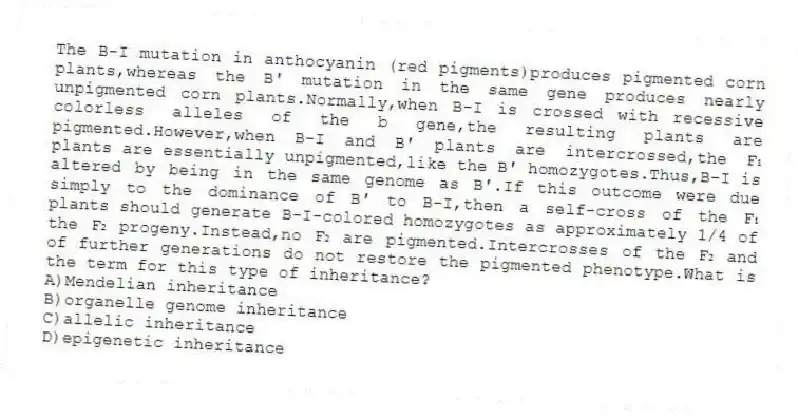
The B-I mutation in anthocyanin (red pigments) produces pigmented corn plants,whereas the B′ mutation in the same gene produces nearly unpigmented corn plants.Normally,when B-I is crossed with recessive colorless alleles of the b gene,the resulting plants are pigmented.However,when B-I and B′ plants are intercrossed,the F₁ plants are essentially unpigmented,like the B′ homozygotes.Thus,B-I is altered by being in the same genome as B′.If this outcome were due simply to the dominance of B′ to B-I,then a self-cross of the F₁ plants should generate B-I-colored homozygotes as approximately 1/4 of the F₂ progeny.Instead,no F₂ are pigmented.Intercrosses of the F₂ and of further generations do not restore the pigmented phenotype.What is the term for this type of inheritance?
A) Mendelian inheritance
B) organelle genome inheritance
C) allelic inheritance
D) epigenetic inheritance
Correct Answer:
Verified
Q3: Predict what would occur in the experiment
Q4: How do chromatin-remodeling complexes recognize the genes
Q5: In the experiment shown in the figure
Q6: Twenty-five years ago,when Oshima and colleagues discovered
Q10: If you extracted mRNA from the following,which
Q11: If natural selection over the time period
Q12: What is a key property of DNase
Q13: The primary difference between an enhancer and
Q29: If the DNA sequence was substantially altered
Q31: If cells of an individual contain the
Unlock this Answer For Free Now!
View this answer and more for free by performing one of the following actions

Scan the QR code to install the App and get 2 free unlocks

Unlock quizzes for free by uploading documents